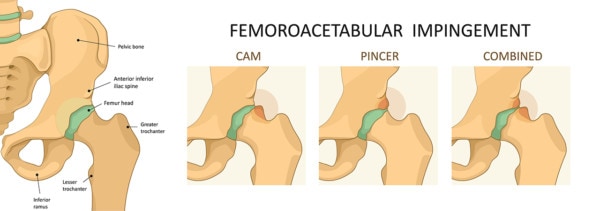Hip Labrum Surgery Complications: Making the Hip Unstable…
This week while practicing down in Grand Cayman I evaluated a professional ballerina from Germany who regrettably is having issues with recovery due to hip labrum surgery complications. In her case, she was diagnosed with CAM and pincer impingement and since having these bone spurs removed has never been able to get back to high level dancing and despite repairing the labrum, like many patients her post-op MRIs still show a torn labrum. Are these hip labrum surgery complications rare or common? In her case, there were all sorts of reasons why nobody should have ever removed the bone spurs in her hip.

Logika600/Shutterstock
Hip arthroscopy rates have exploded over the last decade. Despite that, we still have little high level evidence that these procedures work. One of the more common procedures is to “fix” the labrum and remove bone spurs from the hip in a procedure that is usually called a labral reconstruction or repair. However, we have good evidence that at least one bone spur type (pincer deformity) forms to protect the joint cartilage, so removing it isn’t a good idea. So why are surgeons removing it? Your guess is as good as mine.
Our ballet dancer not only had a labral tear but was also diagnosed with a tear in the one of the main stabilizing ligaments for the hip-ligamentum teres. She also has congenitally loose ligaments, so this woman began her surgical journey prone to instability. Given that the bone spurs formed to try and solve that instability, removing them only guaranteed that she would have an even more unstable hip. In addition, she had other issues as well that went unidentified, as the average orthopedic surgeon just isn’t going to take the time to look at the rest of the equation in the low back, knee, and ankle. However, for a ballet dancer, having optimum function in all of these areas is critical.
In her back, she has a lumbar disc bulge and tear at L4-L5 and L5-S1 (the two lowest discs) which are irritating nerves and causing the muscles in her right leg to operate at much less than 100% efficiency. For a dancer this is a huge issue. She also has a lax ACL ligament in the knee and lax ankle ligaments due to past injuries, all leading to more wear and tear on these joints and the need to use active muscle power to stabilize these areas, which is very fatiguing for someone operating at the level of stage ballet. All of this was invisible to the orthopedic surgeon who treated her hip, which happens all too often. All of it can be treated with injections without more surgery.
The upshot? We’re seeing more and more patients who never fully recover from hip labrum surgery. Despite the explosion in the number of these surgeries being performed, we have no high level evidence that they work well. In this woman’s case, removing the bone spurs around the hip just made for an unstable hip. Hopefully we can help her with precise injection of her own stem cells. At the minimum, we can help many of her myriad instability issues in the leg and the irritated nerves in the back, all of which are as important for a dancer as what’s happening in the hip!

NOTE: This blog post provides general information to help the reader better understand regenerative medicine, musculoskeletal health, and related subjects. All content provided in this blog, website, or any linked materials, including text, graphics, images, patient profiles, outcomes, and information, are not intended and should not be considered or used as a substitute for medical advice, diagnosis, or treatment. Please always consult with a professional and certified healthcare provider to discuss if a treatment is right for you.
